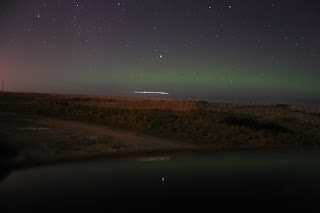Night Sky from Fochabers
I was very impressed with the clarity of the sky from Fochabers Memorial gardens, so thought I would take a couple of shot to finish the night off. Got this nice shot of Orion, Taurus, Jupiter and a meteor, very happy now. :-)
Orion, Taurus and Canis Major
This was a quick 20 second test shot while setting up my camera at Speybay for the Aurora. It just goes to show the quality of dark skies we have here in Moray.
Star Trails a 300 second exposure of Ursa Major and Ursa Minor while attempting to capture a Quadrantid meteor on 04-01-2012

Ursa Major 04-01-2012
Orion this is a two minute exposure taken from my back garden on December 22nd 2011.
M35- Open star cluster in Gemini, Messier 35 (M35, NGC 2168) is consisted of several hundred stars (of which Ake Wallenquist has counted 120 brighter than mag 13) scattered over the area covered by the full Moon (30'); the Sky Catalogue 2000.0 and the first edition of Uranometria 2000.0 give 200 members, the second edition of Uranometria 2000.0 gives 434, while Cudworth (1971) counted 513 probable member stars. At its distance of between 2,700 and 2,800 light years , this corresponds to a linear diameter of about 24 light years; its central density is about 6.21 stars per cubic parsec. Some authors have estimated a larger diameter of up to 46' (H. Shapley in 1930). With about 100 million years it is of intermediate age, and contains some post-main sequence stars (including several yellow and orange giants of spectral type late G to early K). Its hottest main sequence star is given as of spectral class B3 (Sky Catalogue 2000.0), and its Trumpler classification as III,3,r by all sources. It is approaching us at 5 km/sec.
This image is made from twenty 10 second images taken at iso 800 stacked using Registax and procesed in Photoshop.


Vega

M45, The Pleiades or Seven Sisters, The cluster is dominated by hot blue stars that have formed within the last 100 million years. This is a mosaic of four 30 second images blended in Photoshop. Equipment used- Scope-Meade LXD 55 10" SN Camer-Canon EOS 300D (remotly operated from a laptop)

M45, The Pleiades or Seven Sisters, The cluster is dominated by hot blue stars that have formed within the last 100 million years. This is a mosaic of four 30 second images blended in Photoshop. Equipment used- Scope-Meade LXD 55 10" SN Camer-Canon EOS 300D (remotly operated from a laptop)
Messier 38 (also known as M38 or NGC 1912) is an open cluster in the Auriga constellation. It was discovered by Giovanni Batista Hodierna before 1654 and independently found by Le Gentil in 1749. M36 and M37, also discovered by Hodierna, are grouped together with M38 at a distance of about 3,420 light years away from Earth.[1]
Two 30 second light frame and one 30 second dark frame exposures stacked in Deep Sky Stacker made up this image.

NGC 547

NGC 547, The Owl or ET Cluster,
This open cluster is is very easy to find in Cassiopeia, follow a line from Segin and Ruchbah in Cassiopeia 2 degrees towards Andromeda to a binary star Phi cassiopeia which makes up the the brightest stars in the cluster. This is a fun little cluster that the kids will love as it looks like the movie character ET.
This image was produced by stacking eight 30 second, iso 800 frames, ( six light and 2 dark frames), in Deepsky stacker.


NGC 547

NGC 547, The Owl or ET Cluster,
This open cluster is is very easy to find in Cassiopeia, follow a line from Segin and Ruchbah in Cassiopeia 2 degrees towards Andromeda to a binary star Phi cassiopeia which makes up the the brightest stars in the cluster. This is a fun little cluster that the kids will love as it looks like the movie character ET.
This image was produced by stacking eight 30 second, iso 800 frames, ( six light and 2 dark frames), in Deepsky stacker.

Alberio, the binary star system in Cygnus
Sunset over the Isle of Arran on July 28th 2008
Ursa Major and Ursa Minor ( The plough, or Great Bear and Little Bear).

Sunset over the Isle of Arran on July 28th 2008

Ursa Major and Ursa Minor ( The plough, or Great Bear and Little Bear).

























































30-12-07.jpg)



